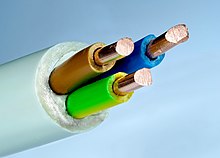Wire
The term cable originally means "rope", from the Latin Capulum, or also from the Hebrew Kabel of "strong rope", but where its popular use of this word has spread the most is as an electric cable, and it is precisely in Israel where the term Kabel has been used for the electrical conductor since ancient times, where it is An electrical cable is a hose made of insulating and protective material that contains an insulated conductor (also electric wire) or a set of insulated conductors (electrical conductor), generally made of copper or aluminum.
Etymology
The term "cable" originally referred to a specific length nautical line in which several ropes were combined to produce a thick, strong cable used to anchor large ships. As electrical technology developed, people shifted from using bare copper wire to using wire bundling and various methods of sheathing and shackles that resembled mechanical wiring, thus the term for electrical wiring was adopted. In the 19th century and early XX, electrical wire was often insulated using cloth, rubber, or paper. Plastic materials are generally used today, with the exception of high-reliability power cords. The term has also been associated with communications due to its use in electrical communications.
Electrical cables
Cables used to conduct electricity are generally made of copper, due to the excellent conductivity of this material, or aluminum which, although it has less conductivity, is lighter for the same capacity and typically cheaper than copper.
Generally, it has insulation in the order of 500 µm up to 5 cm; Said insulation is plastic, its type and thickness will depend on the level of working voltage, the nominal current, the ambient temperature and the service temperature of the conductor.
An electrical cable is made up of:
- Driver: element that drives the electric current and can be of various metallic materials. It may be formed by one or more filaments.
- Insulation: coating that wraps the driver, to avoid the circulation of electric current outside the same.
- Fill cap: insulating material that wraps the conductors to maintain the circular section of the set.
- Cover: is made of materials that mechanically protect the cable. It has as function to protect the isolation of the conductors from the action of temperature, sun, rain, etc.
Components
- Drivers (copper, aluminum or other metal).
- Screening or shielding (used in radio frequency conductors, can be a mesh or tube, smooth or corrugated)
- Insulations (plastic materials, elastomers, paper impregnated in viscous or fluid oil).
- Protections (arms and outer covers additional to insulation to increase resistance to certain critical operating conditions).
Number of drivers
- Unipolar: a single driver.
- Bipolar: two drivers.
- Tripolar: three drivers. It is unifase (brown or black), a neutral (blue) and earth (green and yellow).
- Tetrapolar: 4 drivers. They are two phases (brown and black), a neutral (blue) and earth (green and yellow).
- Pentapolar: 5 drivers. These cables are composed of 3 phases (grey or blue, brown and black), a neutral (blue) and earth (green and yellow).
Materials used
- Copper
- Aluminium
- Constantán, a copper alloy
- Almelec, aluminum alloy
Driver flexibility
- Rigid driver
- Flexible driver
Conductor insulation
- Thermoplastic insulation:
- PVC - (vinyl polychloride)
- PE - (polyethylene)
- PCP - (polycloroprene), neoprene or plastic
- Thermal insulation:
- XLPE - (reticulated polyethylene)
- EPR - (ethylene-propylene)
- MICC - Mineral-aisled copper-coated cable
- PTFE - Resistance to chemical attack
Insulating materials for high voltage cables
- Paper cable impregnated:
- Paper impregnated with non-migrant mixture
- Paper impregnated with fluid oil
- Extrusion polymeric insulation cables:
- Cross-chain polyethylene (XLPE)
- Propylene ethylene (EPR), hardening version (HEPR)
- High density thermoplastic polyethylene (HDPE)
Electrical communication cables (electrical conductors)
- Pair cable
- Coaxial cable
- Wired wire
- Braided pair cable
- Hilo de Litz
Optical conductors
Light conductors (English: coil): in this case, the coating, while protecting the conductor itself, also prevents the scattering of light and thus the loss of signal. For this reason it is used to send information over long distances quickly and with very high quality.
Mechanical force conductors
Employed for the mechanical transmission of movement, or loads among other mechanical elements, such as levers, wheels, and pulleys; perform their work in traction or rotation.
For more information
- R. M. Black, The History of Electric Wires and Cables, Peter Pergrinus, London 1983 ISBN 0-86341-001-4
- BICC Cables Ltd, "Electric Cables Handbook", WileyBlackwell; London 3rd Edition 1997, ISBN 0-632-04075-0
Contenido relacionado
Technology
Robotics
Electricity



